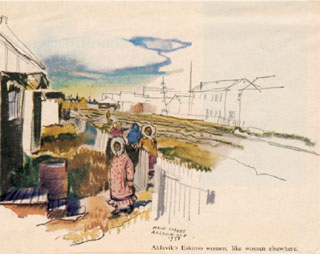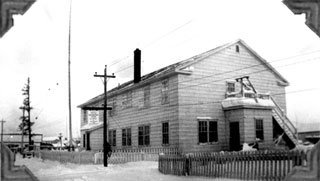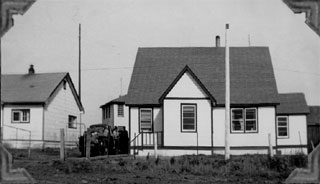Page 7: Aklavik (continued)
Living
There
We
discovered very soon that the inhabitants of Aklavik were full of
the usual northern kindness, goodwill, and good cheer, and they soon
made us feel very much at home. We found ourselves much enjoying the
new (to us) life of a small town in contrast to that of the very much
smaller settlement of Fort Providence.
When we walked through the town, I was interested to see that the
inhabitants wore a different version of northern dress from those
of Fort Providence or Yellowknife. The fashions in parkas were quite
different from what people wore in the Slavey settlements further
south, around Great Slave Lake.

The
women wore longer, ankle-length parkas; the men wore hip-length ones
with smaller hoods than the women's. Over their long caribou-skin
parkas the women wore brightly coloured patterned cotton parka covers.
These were trimmed with colourful rickrack and plain braid, sewn in
rows above a gathered flounce that formed the hem of the garment.
In the large parka hood, which was trimmed with beautiful fur, women
sometimes carried a blissfully comfortable baby, whose little face
could be seen peering happily over its mother's shoulder. This style
of dress was very attractive and colourful. Some of the older women
had tattoos on their faces, but this seemed not to be the fashion
among the younger women.
The
streets of Aklavik were, of course, unpaved, and consequently quite
muddy in rainy weather, but this seemed quite natural to us after
our years in Fort Providence. However, we fully appreciated the convenient
boardwalks running alongside the streets, which made it much easier
to walk in rainy, muddy, or snowy weather.
Earlier
in the century the Anglicans and Roman Catholics had each locally
established a mission, a church, a hospital, and a residential school
for the children of families living outside the town. For Aklavik
families, the federal government provided a day school, which had
an excellent staff headed by a cheerful and energetic principal, "Moose"
Kerr. "Moose" was a northern nickname usually given to anyone
who was tall and long-legged, and Moose Kerr was both. He was a real
asset to the community, and as a tribute to his good work, the present
school bears his name.
A
large Hudson's Bay post supplied Aklavik's shopping centre. An RCMP
detachment, commanded by a sergeant, provided law and order to the
town and the surrounding delta country, and an RCN detachment, the
proud possessors of the only snowmobile in town, represented the Navy.

Government
administration building, with grave of the Mad Trapper at left.
The
government administration building - the sub-district office of the
Department of Resources and Development - was located on the main
street, with the Signals station nearby. Just around the corner, in
a row of houses looking on to the river, was the residence of the
assistant commissioner, who was head of this government office.
The
Mad Trapper
Perhaps Aklavik's chief tourist attraction nowadays (in 2003) is the
grave of the famous Mad Trapper of Rat River. The story of Albert
Johnson, the Mad Trapper, is part of the history of the town and a
part of Signals history too. Johnson had been springing or removing
traps set by other Rat River trappers, and he wounded one of the two
RCMP constables sent to question him about these incidents. After
a long chase in severe winter weather, he was shot in an exchange
of fire with the search party who finally found him. Included in the
volunteer search party as adjuncts to the RCMP were two Signals staff,
Q.M.S. Frank Riddell and Staff Sergeant "Heps" Hersey.
The
Mad Trapper's grave, we were told, was beneath the lone fir tree beside
the government administration building on the main street. The full
fascinating and graphic story of the search party's long pursuit in
bitterly cold weather is available on the NWT and Y Web site.
CHAK:
the Friendly Voice of the Arctic
The
Signals radio station was at that time the most northerly year-round
station of the Northwest Territories and Yukon Radio System. One of
its substations was in Tuktoyaktuk, on the coast about thirty miles
east of the Mackenzie River's outlet into the Beaufort Sea.
One
of Dick's responsibilities was to maintain the operation of the local
radio station, CHAK, "The Friendly Voice of the Arctic."
The station was located in a very small building on the main street,
not far from the Signals radio station and the government administration
building. It had been built in 1947 by WO1 "Red" MacLeod,
who was then in charge of the Signals radio station, and his staff
of five. It provided Aklavik and the surrounding delta country with
entertainment, education, local weather reports, and news. Perhaps
most important of all, it relayed messages between the reindeer herders,
and the trappers out on their trap lines in the Delta, and their families
in Aklavik. This particular part of the territories is the third-best
area in Canada for muskrat trapping, with eighty thousand skins being
taken in one season. After the ratting season opened on March 1, the
town usually emptied of most of its citizens as the Natives and their
families left for their traplines. The day school marked time during
this period, as many of its pupils left with their families to help
and to acquire trapping expertise.
CHAK
was a very valuable resource for its listeners and was much appreciated
by the inhabitants of the delta. A committee of local townspeople,
chaired by LACO Hunt, provided the programming for the station and
acted as announcers and presenters.

Aklavik:
permanent married quarters, with Signals radio station behind houses.
PMQ
As
in Fort Providence, houses had been built along the riverbank facing
the river. Our new abode was one of those houses, and we were pleased
to find a convenient boardwalk running along outside the front-yard
fences. In this setting I saw a resemblance to the houses facing the
sea on the "front" of an English seaside resort.
Our
PMQ had been built in 1949 to the same CMHC plans as our house in
Fort Providence. But this time, instead of facing the bush, our living-room
windows looked out on the Mackenzie River.
But
the biggest difference between these two PMQs was that the new house
was already furnished. This we very much appreciated, as it saved
us the considerable amount of time and trouble it would have taken
to pack our family furniture, goods, and chattels and have them loaded
on a riverboat for transport downriver to Aklavik - and hope that
they would arrive before we did.
The
furnishings provided were ideal for a young family: good, solid maple
Gibbard furniture in the colonial style, and in a pleasant mellow
golden shade too. Pretty flower-patterned curtains were at the windows
and the whole house appeared both welcoming and practical.
There
was one slight drawback though - in the kitchen equipment. The pots
and pans were of a size suitable for an army cook. However, we had
been warned of this by the outgoing tenants, so I had taken my own,
somewhat smaller, utensils with me.
What
we wished to retain of our Fort Providence furniture we had had crated
and sent to storage "outside" via the usual barge and train
route, but we did have a few indispensable bits and pieces sent on
to Aklavik. These included my small portable sewing machine, a reliable
iron, a food mixer, a diaper pail, a small crib, our eiderdowns, a
box of books, and, I think, our wringer washing machine (I cannot
remember if one was supplied with the house). All of these items duly
arrived quite soon by river, on one of the barges that were pushed
downriver by the busy tugs.

Mackenzie
River, with the Richardson Mountains in the distance and Chris and
Jill in the foreground.
From
our front windows we could watch the rapidly flowing water of the
summer river gradually change to the solid ice of winter. During the
short summer season we could see a constantly changing congregation
of vessels: Inuit fishing schooners from Banks Island, the regular
river workhorse tugs and barges that had started their journey on
Great Slave Lake, and the small local boats powered by "kickers."
After winter came and ice had formed on the river, children playing
on the riverbank had to watch out for sleds and dog-teams; guided
by their drivers, they would suddenly veer from their route along
the frozen river and race up the bank towards the delights of town.
[Next
Page]
Pages: [1] [2]
[3] [4]
[5] [6]
[7] [8] [9]
[10] [11]
[12] [13] [14]
[15] [16]
Return to top of
page
Return to the Watts
Family page